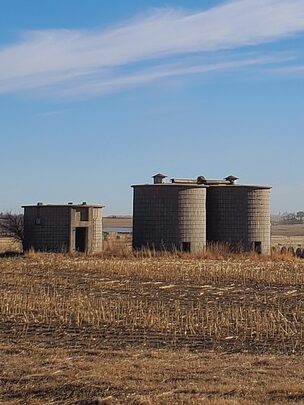Many grain bins are standing empty in farming communities as farmers use other means of storing grains. Alternative housing lovers are turning to grain bins to create silo homes for themselves and their families.
What were grain bins used for, and why do they sit today?
Farmers commonly use grain bin silos to store grains such as rye, barley, wheat, corn, and oats. Morning Ag Clips states, “Silos are rarely erected today for farming. Farmers are looking for faster feeding and environmentally beneficial storage methods. They are moving towards bunker silos or flat storage rather than tower storage. The long, white bags you see snaking near cow barns are filled with nutritious feed. Plastic bales of hay are easier to work with and faster to access. This trend toward flat storage began about 20 years ago.”

This adaptation toward a more efficient and faster way of storing feed and hay has left American farming icons unattended. Some farmers are starting to sell grain bin silos to remove the structure from their property and earn little money.
Where are grain bin houses becoming more common?
Grain bin houses are becoming more common in areas that have large agricultural industries, such as Iowa, Wisconsin, Nebraska, Minnesota, Missouri, Illinois, and Texas. Farmers are either selling their old grain bins or renting them out to those who want to build their own grain bin houses.
People are building grain bin houses in the city to live sustainably and save money. You can save a lot of money on your monthly bills if you go off the grid and live without city utilities like water and electricity. However, they are an alternative form of housing, so you’ll want to check with your local building and planning supervisors before starting your build.

What is the living area of a grain bin house?
The size of the bin will determine the size of the house. The living area of a grain bin house can range from 100 to 1,500 square feet. The living area will vary depending on the style of the house you want to build. You can build an open-concept house or a closed-off house with walls built around the bin.
The beauty of using grain bin silos is that you can build two, three, or more together with walls in between to make a larger structure. While the silo might have minimum square footage, there are ways to build up and out to increase your space.
How to find grain bin house plans?
You can find grain bin house plans online. You can also hire a designer or architect to custom-build your house. You can also repurpose grain bins for other structures, such as gazebos, pavilions, or even a playhouse for the kids. Grain bin plans for other structures can give you ideas for repurposing a grain bin. You can also find books and magazines at your local library on how to build a grain bin house.
Grain bin plans for other structures
Gazebos, bars, or playhouses – A gazebo, outdoor bar, or playhouse can be built as a freestanding structure or as an addition to your house. You can build these structures using a grain bin roof and side walls. A grain bin roof and side walls are made of metal and can withstand harsh weather, which is perfect when you want to relax or give the kiddos extra room to play. A gazebo built out of a grain bin can last for decades.
Can you DIY a grain bin house?

Yes, you can DIY a grain bin house, but it is not a project you want to take on if you do not have any construction experience. Working with a contractor with experience building grain bin houses is best. You can find contractors in your local area by visiting online contractor directories.
To DIY a grain bin house, you must excavate a foundation and build a proper structure. The interior must undergo the same construction process as a stick-built house. You will also need to buy a grain bin and have it delivered to the construction site, seal it properly against rain, and install metal roofing sheets and side walls.
You’ll need to insulate the walls for your area and run the proper electrical, plumbing, and ductwork for heating and cooling. Then you’ll need to put up drywall, form your interior walls, finish them and begin the build-out of other interior structures. If you’re going to live in it year-round, you’ll want to spend the time to do it right, as the process can be very involved.
Is the grain bin house considered a tiny house?
The size of a grain bin house could fall into the tiny house category. A grain bin house is usually around 1,000 square feet. Tiny houses usually range between 100 and 400 square feet. Both structures are small, eco-friendly houses built to be sustainable and cost-effective.
Can you use a grain bin house as an Airbnb rental?
Yes, you can use a grain bin house as an Airbnb rental. You can design the house however you want and style it for long-term or short-term guests. What you can charge depends on the rental rates in your area and could range between $60 and $100 per night.
They are perfect for those who want to experience sustainable living or those who want to save money on their monthly bills.
What is the cost of a grain bin house?
The cost will depend on the type of grain bin or lid you choose. It can range from around $8,000.00 for a used grain bin to $50,000.00 for a new one. The double-walled bin is usually higher because it’s more durable and has a more intricate construction process. The cost will also depend on the size of the bin and the size of the house you intend to build. You can use a 16-foot grain bin to build a tiny house or a 32-foot bin to build a large one. A bin that is 20 feet wide and 32 feet long can make a 1,000-square-foot house.
How much does a used grain bin house cost?
Finding a grain bin in good condition and well taken care of is best. A used grain bin can cost between $0 and $8,000.00. You can find used grain bins in your local area by searching online or through classified ads. If you live in an urban area, you may be able to find a used grain bin at a feed mill.
General costs overall to build a grain bin house?
Building materials can cost between $10,000.00 and $40,000.00. Add another $2,000.00 for utility hook-up and $1,000.00 for a septic system. Your overall costs will also depend on the types of furnishings you use during construction.
Building a grain bin silo house is an original idea in any area
Grain bin silo homes are an attractive alternative housing option. By adding personal touches like terraces, porches, additional levels, and wings, you can create a home that is as unique as you. With every build, remember to check with your local building and planning department to be sure you can have this type of structure in your area.
Whether you want to travel the world or put down roots (maybe a treehouse), or a silo house an alternative housing solution will fit your lifestyle. Check out 25 Alternative Housing Ideas to Fit Your Lifestyle.


